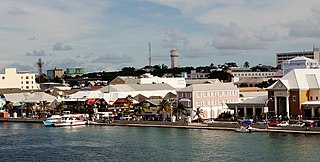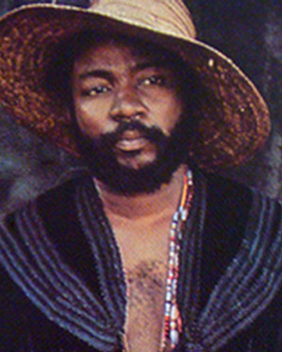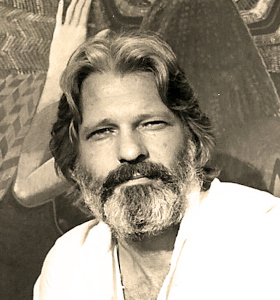Related Research Articles

Nassau is the capital and largest city of The Bahamas. It is located on the island of New Providence, which had a population of 246,329 in 2010, or just over 70% of the entire population of The Bahamas. As of April 2023, the preliminary results of the 2022 census of The Bahamas reported a population of 296,522 for New Providence, 74.26% of the country's population. Nassau is commonly defined as a primate city, dwarfing all other towns in the country. It is the centre of commerce, education, law, administration, and media of the country.
The music of the Bahamas is associated primarily with Junkanoo, a celebration which occurs on Boxing Day and again on New Year's Day. Parades and other celebrations mark the ceremony. Groups like The Baha Men, Ronnie Butler,Kirkland Bodie and Twindem have gained massive popularity in Japan, the United States and other places. Other popular Bahamian artists include Stileet and Stevie S.

Junkanoo is a festival that was originated during the period of African chattel slavery in British American colonies. It is practiced most notably in Jamaica, The Bahamas and Belize, and historically in North Carolina and Miami, where there are significant settlements of West Indian people during the post-emancipation era. In the present day, there are considerable variations in performance and spelling, but there are the shared elements of masquerade, drumming, dance, and parading.
Edward Clement Bethel was a Bahamian composer, pianist and choral director who became the first Director of Culture in the Bahamas.
Bahamian culture is a hybrid of African, European, and other cultures.
Avvy is a songwriter and performer contributing to the art of Bahamian folk music, Junkanoo and Rake-and-scrape. In 2014 his singles "Dirty Nagua Rake" and "Swing Swing" took top position in the local Bahamian charts.

Macfarlane Gregory Anthony Mackey, known professionally as Tony McKay and Exuma, was a Bahamian musician, artist, playwright, and author best known for his music that blends folk, rock, carnival, junkanoo, calypso, reggae, and African music stylings.

Richard Brent Malone, MBE was a Bahamian photorealist painter and gallery owner.
Antonius Roberts is a Bahamian artist, teacher, and curator. He is known for his installations and sculptures. Roberts was one of the founders of the art group "B-CAUSE" in 1991.
Horace Kenton Wright, was a Bahamian artist and teacher, considered to be one of the "fathers of modern Bahamian art." He was known in particular for his watercolors.

Blue Curry is a Bahamian artist living and working in London, specialising in sculptural assemblage and installation art.
Afro-Bahamians are an ethnicity originating in The Bahamas of predominantly or partial native African descent. They are descendants of various African ethnic groups, many associated with the Bight of Biafra, kingdoms, the Oyo Empire, and the Kingdom of Kongo. According to the 2010 census, 92.7% of The Bahamas' population identifies as mixed African descent.
Amos Ferguson was a Bahamian folk artist. He was known for his brilliantly colored Bible stories and Bahamian scenes. He was nicknamed the "Picasso of Nassau".

Tavares Henderson Strachan is a Bahamian-born conceptual artist. His contemporary multi-media installations investigate science, technology, mythology, history, and exploration. He lives and works in New York City and Nassau, Bahamas.
André Toussaint was a Haitian singer and guitarist who emigrated to Nassau, Bahamas in 1953 and performed there until his death in 1981. He sang and recorded in several languages and in a variety of styles, most notably calypso.
Lavar Munroe is a Bahamian-American artist, working primarily in painting, cardboard sculptural installations, and mixed media drawings. His work is often categorized as: a hybrid medium that straddle the line between sculpture and painting. Munroe lives and works in the United States.
Kendal Hanna was a painter and sculptor known as one of The Bahamas’ first abstract expressionist. His works have been inspired by and compared to international artists and fellow abstractionists such as William de Kooning, Jackson Pollock, Hans Hoffman, Joan Miró and Mark Rothko.
Meta Davis Cumberbatch MBE was a Trinidad-born pianist, composer, poet, playwright and cultural activist, who spent the majority of her life in The Bahamas, where she used her talents to enhance the country's cultural development, becoming known as the "Mother of the Arts". At the 2014 Independence anniversary celebrations in Nassau she was honoured as a Bahamian "Cultural Warrior".
Tamika Galanis is a Black Bahamian multimedia artist and documentarian examining topics of Bahamian identity and culture, tourism, and archival histories.
References
- 1 2 3 4 5 6 7 Willis, Natalie (21 October 2019). "From the Collection: 'Solomon' (2000) by Stan Burnside". National Art Gallery of the Bahamas. Archived from the original on 28 March 2023. Retrieved 28 March 2023.
- ↑ "Stanley Burnside and Jackson Burnside | Interview | American Masters | PBS". American Masters. 5 October 1998. Archived from the original on 28 March 2023. Retrieved 28 March 2023.
- 1 2 3 "Burnside, Stanley". The D'Aguilar Art Foundation, Nassau, Bahamas. Archived from the original on 27 February 2023. Retrieved 27 March 2023.
- 1 2 3 4 Rappolt, Mark (25 November 2022). "Stan Burnside and Tavares Strachan: 'We Get to Make Meaning'". ArtReview. Archived from the original on 27 February 2023. Retrieved 28 March 2023.
- 1 2 Koster-Walton, Chelle (2010). Explorer's Guide Bahamas: A Great Destination. The Countryman Press. p. 31. ISBN 978-1-58157-853-9.
- ↑ "Naughty to host stage show during Marathon Bahamas". The Tribune. 8 January 2016. Archived from the original on 28 March 2023. Retrieved 28 March 2023.
- 1 2 "Burnside, Beadle & Roberts". The Current. Archived from the original on 28 March 2023. Retrieved 27 March 2023.
- ↑ Craton, Michael; Saunders, Gail (1992). A History of the Bahamian People: From the Ending of Slavery to the Twenty-First Century. University of Georgia Press. p. 485. ISBN 978-0-8203-2284-1.
- ↑ Burnside, Jackson (19 November 2010). "'Artists of the Bahamas' to open in unique city-wide exhibition". The Bahamas Weekly. Archived from the original on 28 March 2023. Retrieved 28 March 2023.
- ↑ Cox, Albert (9 July 2014). "Honouring cultural icons of the Bahamas". The Tribune. Archived from the original on 28 March 2023. Retrieved 28 March 2023.
- ↑ Benjamin-Smith, Dionne (23 May 2014). "Local artist gives Bahamian touch to IAAF World Relays". The Bahamas Weekly. Archived from the original on 28 March 2023. Retrieved 28 March 2023.
- ↑ Massey, Rebecca (8 March 2011). "Lyford Cay International School (LCIS) students experience a unique artistic presentation from Stan Burnside". The Bahamas Weekly. Archived from the original on 28 March 2023. Retrieved 28 March 2023.
- 1 2 3 Gottardi, Angela. "Selected Bibliography from the Special Collections Department of the College of the Bahamas Library". The College of The Bahamas Library. p. 85. Archived from the original on 28 March 2023. Retrieved 28 March 2023.
- 1 2 "Cartoonist Stan Burnside says leaked letter was an 'invasion of privacy'". Eye Witness News. 26 July 2019. Archived from the original on 28 March 2023. Retrieved 28 March 2023.
- 1 2 Ruprecht, Alvina Roberta; Taiana, Cecilia (1995). Reordering of Culture: Latin America, the Caribbean and Canada in the Hood. McGill-Queen's Press - MQUP. p. 415. ISBN 978-0-88629-269-0.
- ↑ Smith, Rogan (31 July 2019). "Sideburns: The End Of An Era". This Bahamian Gyal. Archived from the original on 28 March 2023. Retrieved 28 March 2023.
- ↑ "Stan Burnside Exhibition opens May 28th". The Bahamas Weekly. 20 May 2010. Archived from the original on 28 March 2023. Retrieved 28 March 2023.